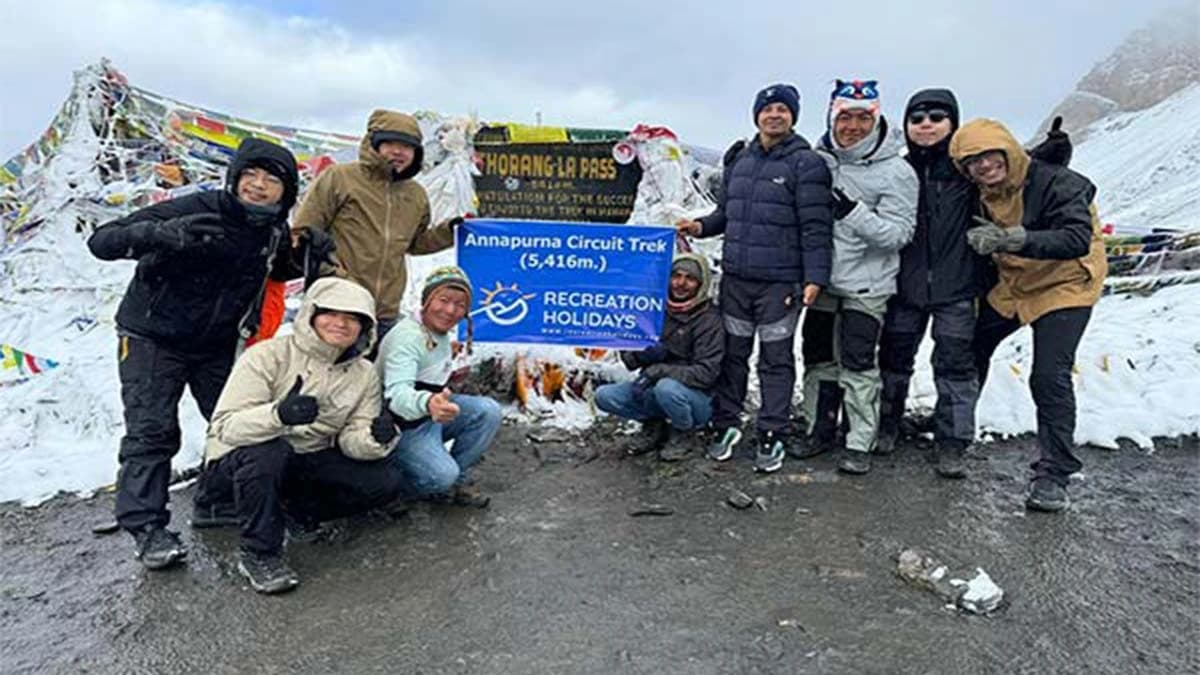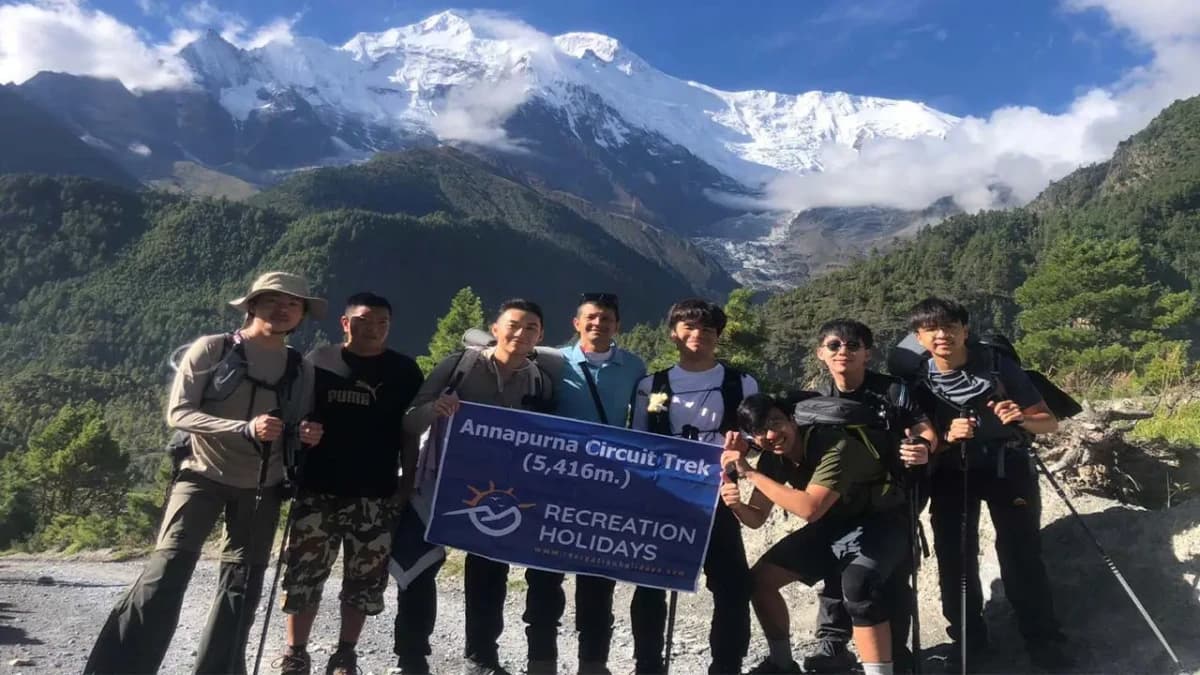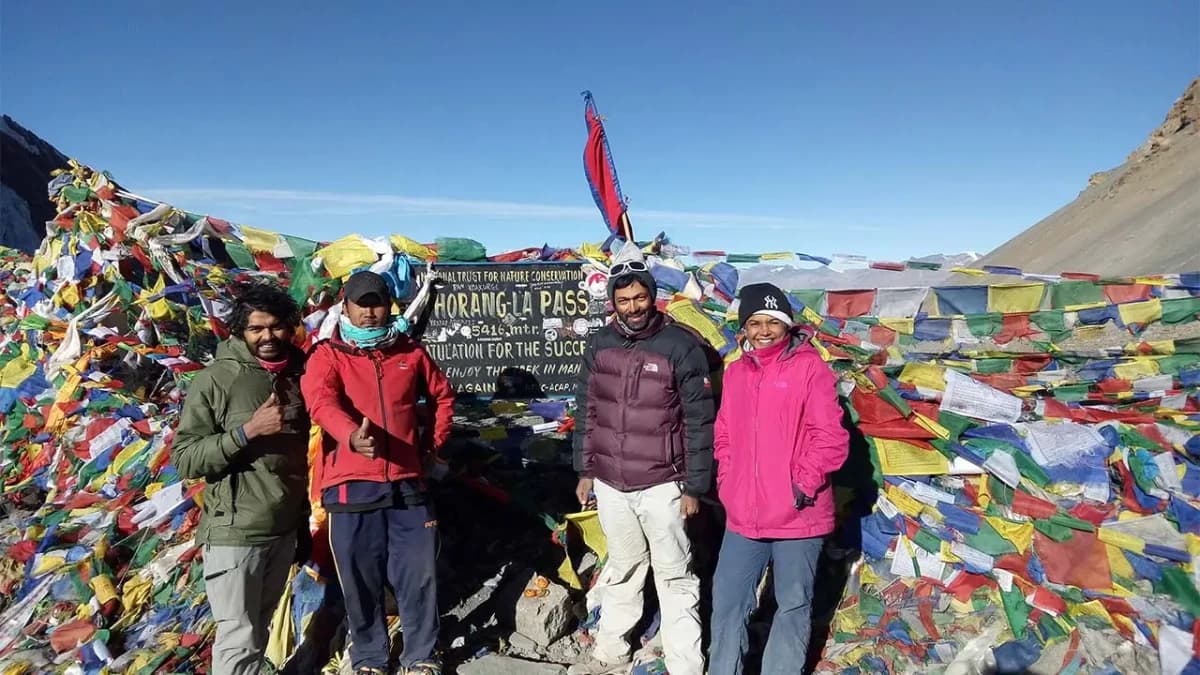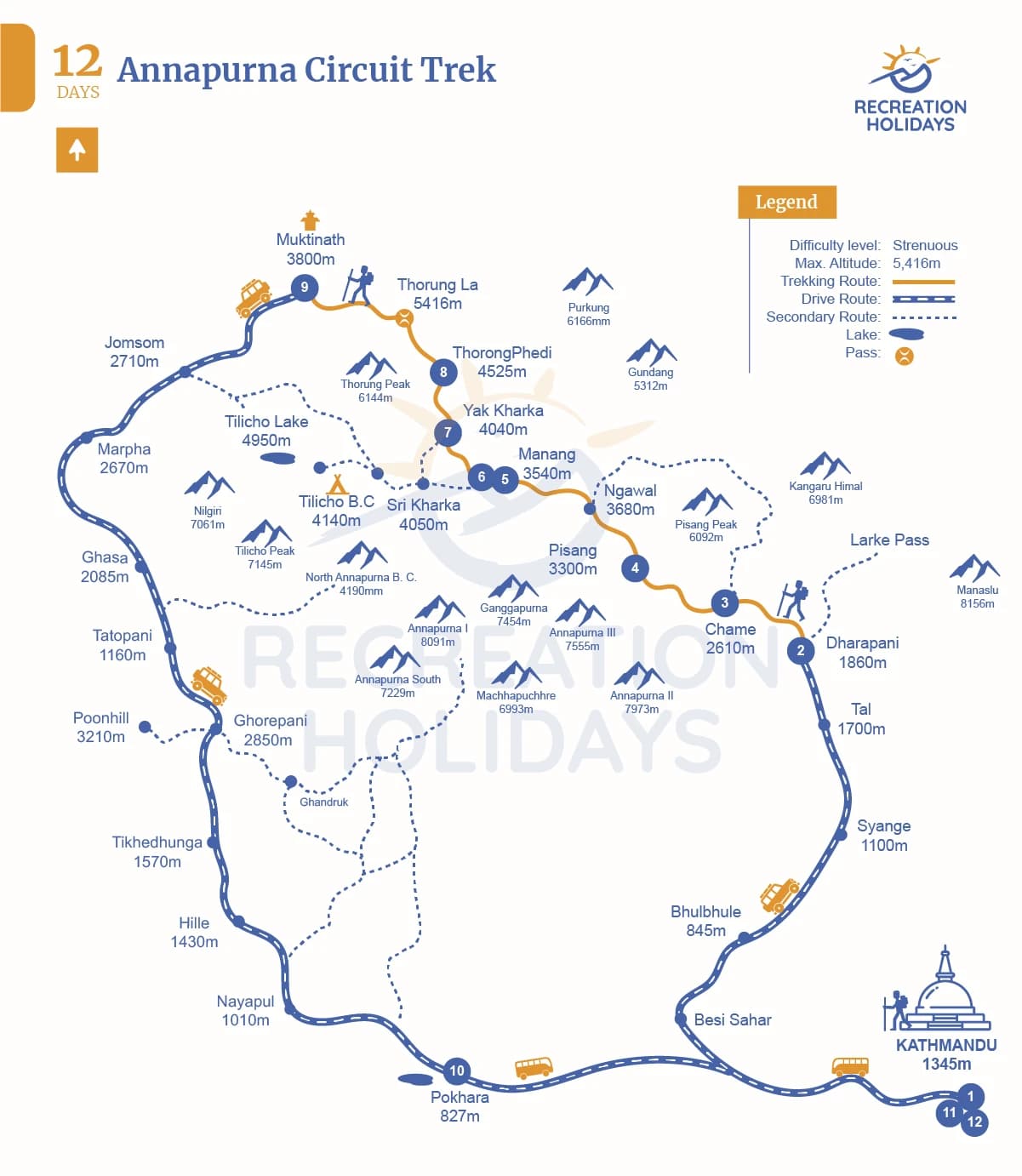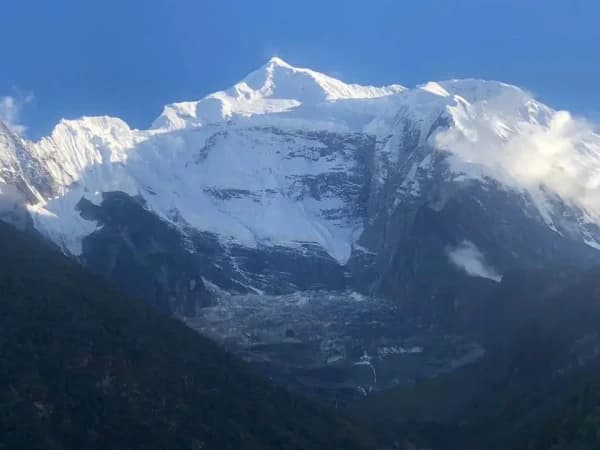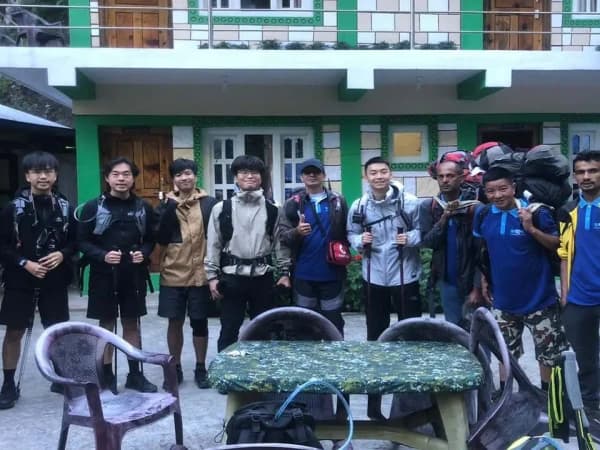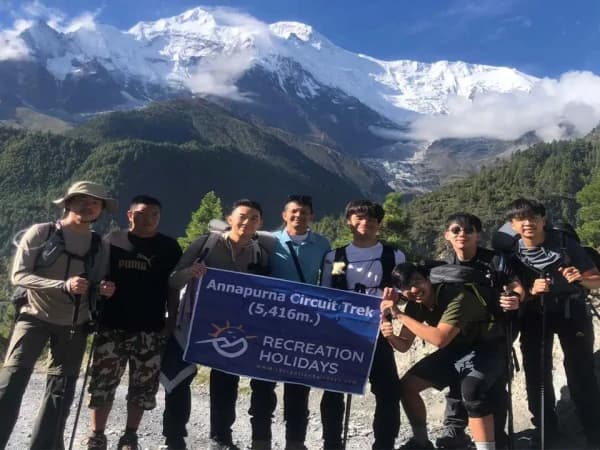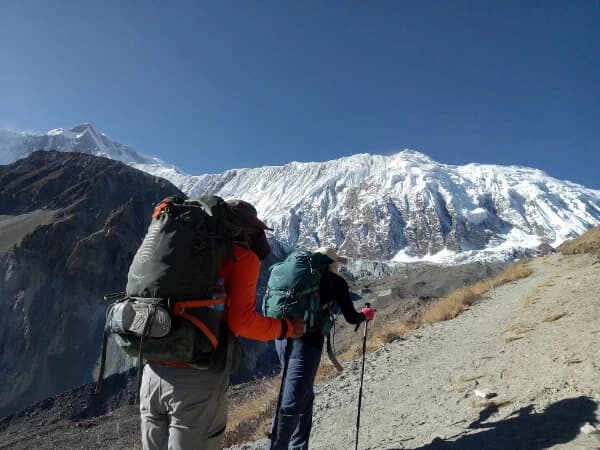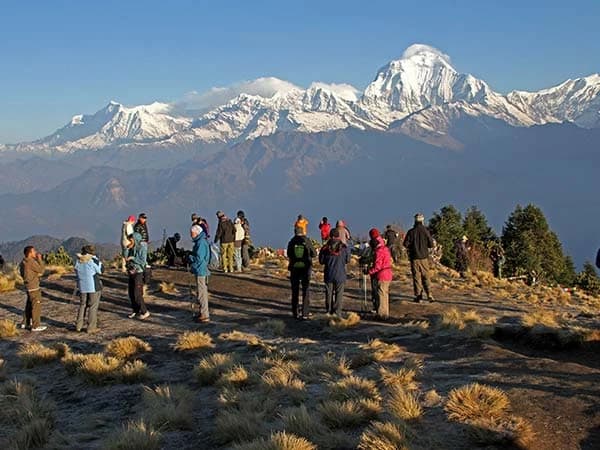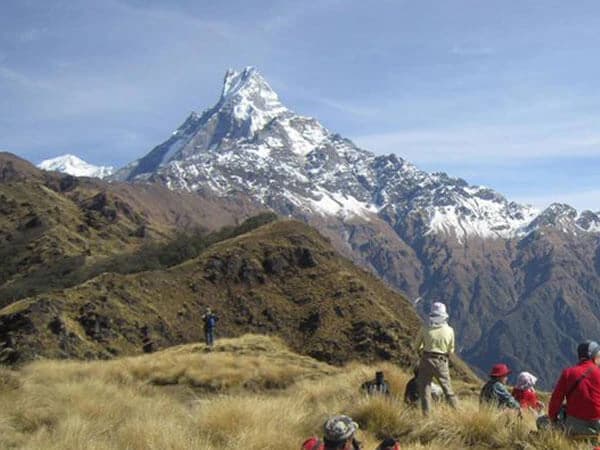The 12-day Annapurna Circuit Trek by Recreation Holidays offers stunning Himalayan views, diverse cultures, and the challenge of crossing Thorong La Pass. Priced at $840, it includes guides, meals, permits, and teahouse stays, ideal for adventure seekers in Nepal.
Annapurna Circuit Trek 12 Days
Highlights of the Trek
- A rare opportunity to circle the 10th highest mountain in the world through shifting landscapes, cultures, and altitudes
- Conquering Thorong La Pass (5,416m/ 17,770ft), one of the world’s highest trekking passes, with 360° views of the snowbound peaks
- Experience diverse climatic zones in one trail, from subtropical forest and paddy field to alpine meadows, high-altitude desert, and glacial valley
- Stunning panorama of peaks like Annapurna, Dhaulagiri, Gangapurna, Tilicho Peak, Machhapuchhre, and many more
- Cultural immersion in the Himalayan villages of Gurung, Thakali, Magar, and Manangis
- Acclimatization day in the stunning high-altitude village of Manang with optional side trips to Ice Lake, Gangapurna Lake, or Praken Gompa
- Visit the sacred Muktinath temple with 108 holy water spouts, eternal flames, and stunning Himalayan vistas in the backdrop
- Walking through the world’s deepest gorge, Kali Gandaki Gorge, perched between the Dhaulagiri and Annapurna massifs
- Soothing natural hot springs at Tatopani, a favorite recovery spot for trekkers
- Staying at an authentic Nepal teahouse, enjoying the diverse local cuisines
- One trek, many worlds; no trek offers you such diverse geography, culture, and altitudes
If you are looking forward to experiencing the legendary Annapurna Circuit without committing to a three-week itinerary, the Annapurna Circuit Trek 12 Days is the perfect balance of adventure and efficiency. This itinerary plan is designed for trekkers who are short on time but don’t want to miss the core highlights. Our version of trekking in Nepal around Annapurna smartly trims the long-winding dusty road section and focuses on a real trekking experience without losing the essence.
From the very start of the Annapurna Circuit Trek in Nepal, you will traverse through worlds of lush forests, roaring rivers, deep gorges, terracedfarmland, and gradually to the high-altitude alpine valleys. The trails across the arid deserts, alpine pastures, and Himalayan passes stretch beneath the shadow of giants like Annapurna, Ganagapurna, Tilicho, and Dhaulagiri. Along the way, trekkers also encounter the mosaic of traditional mountain communities, each preserving unique languages, customs, and religious traditions that are deeply rooted in the Himalayan history.
So, what makes Annapurna Circuit truly exceptional is its diversity, not only in geography but also in culture, climate, and overall experience. Despite the shortened timeframe, the 12-day Annapurna Circuit Trek itinerary maintains the trek’s signature diversity and intensity. It does demand physical fitness and mental resilience as the trail stretches across significant altitude points and diverse climatic zones. However, this itinerary also provides ample opportunity for acclimatization, cultural interaction, and moments of reflection amidst the most breathtaking mountain scenery on the planet.
For adventure seekers looking for a comprehensive yet time-efficient journey, this Annapurna Circuit guided trek presents an ideal balance, offering a rewarding Himalayan trekking experience. This exhilarating adventure package captures the true spirit and grandeur of the majestic Annapurna region, which is perched at the heart of the Himalayas.
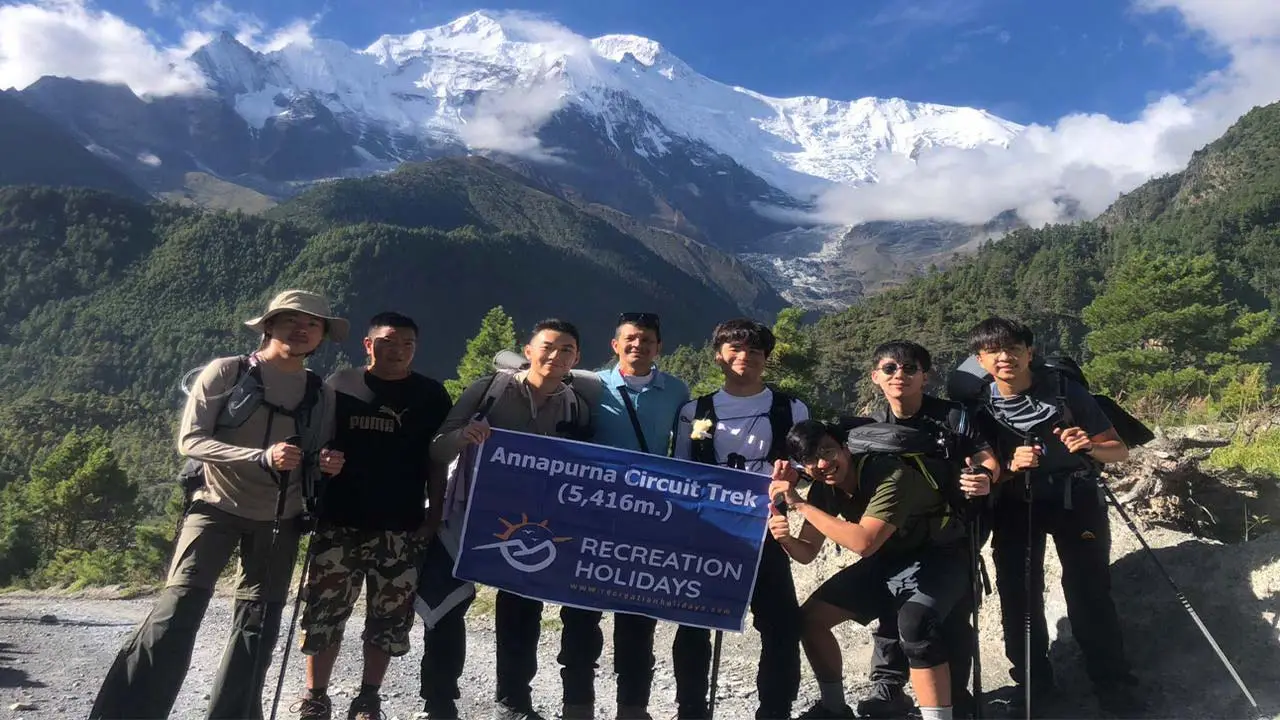
Annapurna Circuit Trek 12 Days Itinerary (Outline)
Planning a trek around Annapurna means understanding more than just the trekking route. It is also about understanding your ascent, acclimatizing properly, and knowing what you can expect during each day of your journey. Below is a day-by-day itinerary outline complete with altitude profile, walking duration, and elevation chart to help you visualize your Himalayan adventure.
|
Day |
Annapurna Circuit Trek 12 Days Itinerary |
Duration |
Altitude Chart |
|
01 |
Arrival in Kathmandu (1,345m/ 4,412ft) and hotel transfer |
|
|
|
02 |
Drive from Kathmandu to Dharapani (1,860m/ 6,102ft) |
8 to 9 hours (drive) |
515m/ 1,689ft (gain) |
|
03 |
Dharapani to Chame (2,610m/ 8,562ft) trek |
5 to 6 hours |
750m/ 2,460ft (gain) |
|
04 |
Trekking from Chame to Pisang (3,300m/ 10,826ft) |
5 to 6 hours |
690m/ 2,263ft (gain) |
|
05 |
Trek from Pisang to Manang (3,540m/ 11,615ft) |
5 to 6 hours |
240m/ 787ft (gain) |
|
06 |
Acclimatization day in Manang |
|
|
|
07 |
Trek from Manang to Yak Kharka (4,060m/ 13,320ft) |
4 to 5 hours |
520m/ 1,706ft (gain) |
|
08 |
Yak Kharka to Thorong Phedi (4,525m/ 14,845ft)
|
4 to 5 hours |
465m/ 1,525ft (gain) |
|
09 |
Thorong Phedi to Muktinath (3,800m/ 12,467ft) via Thorong La Pass (5,416m/ 17,770ft) |
8 to 9 hours |
891m/ 2,923ft (gain) |
|
10 |
Drive from Muktinath to Pokhara (827m/ 2,713ft) |
5 to 6 hours |
2,973m/ 9,753ft (loss) |
|
11 |
Drive from Pokhara to Kathmandu (1,345m/ 4,412ft) |
6 to 7 hours |
518m/ 1,699ft (gain) |
|
12 |
International departure |
|
|
Annapurna Circuit Trek 12 Days Itinerary
Your Annapurna Circuit Trek in Nepal begins from the heart and the vibrant capital of the country. As you step out of the Tribhuvan International airport, you will be greeted by an atmosphere that is distinctly Himalayan; cool mountain air, distant city commotion and incense dust.
Outside the terminal, our representative will be waiting with a placard with your name. You will then be swiftly transferred to your hotel in Thamel, the main tourist area of Kathmandu. This drive will introduce you to the city’s slow pace. You will see streets filled with bikes, cars, pedestrians and roadside vendors.
After checking in at your hotel, you can take some time to rest or explore the nearby area of Thamel, lined with restaurants, cafes and gear shops. As this is also a trek preparation day, this is the best chance to get what you need before heading into the mountains.
In the evening, you will attend a pre-trek briefing. Your guide will provide details about the overall journey, what you can expect, what you should prepare for and dos- don'ts. This briefing will also be an opportunity to meet your trekking team if you are doing a group trek.
Your journey to Annapurna truly begins today as you leave behind the hustle and dust of the capital’s chaotic rhythm. As you leave the valley behind, the road merges onto the Prithvi Highway. The driving road twists alongside the Trishuli River and you will reach Mugling.
You will continue driving toward Dumre, another key junction town. From Dumre, the road climbs steadily toward Besisahar, nestled in the Marsyangdi River Valley. Along the way, you pass other beautiful settlements like Ngadi, Bhulbhule and Jagat before reaching Dharapani.
Dharapani is located in the Manang District and sits in a peaceful valley surrounded by stunning Himalayan vistas. Once you arrive at Dharapani, you will have the rest of the evening to rest and acclimatize to the altitude.
As you leave Dharapani, the path follows the Marsyandi River. The landscape starts to gradually shift as you move further up into the valley, with dense pine forests surrounding the trekking trail. This section of the trek is relatively moderate and has steady, winding stretches.
You will be able to acclimatize while enjoying the peaceful environment. As you continue with the scenic trail, you will arrive at Bagarchhap. As you climb higher, the air thins and the forest grows taller. Then, in the next stretch, you arrive at Danaque Village. It is a quiet village with few tea shops.
From Danaque, you follow a switchback climb that leads you to Timang Village. During a clear day, views of Manaslu from here are simply breathtaking. Continuing further, the trail meanders across the pine forests and open pastures toward Thanchowk.
Then, finally, you arrive at Chame, the administrative center of Manang District. Chame has government offices, health posts and better lodges. This destination on the 3rd day of your Annapurna Circuit Trek Itinerary is more than just a checkpoint. It is a turning point where you start to sense a sense of isolation, thin air and shift into the mountain terrain.
After a warm breakfast in Chame, where the morning is cold and silent, you will continue your trek through the winding trail lined by lush pine woodland. You begin your trek by following the eastern bank of the Marsyandgi River heading toward the narrower and dramatic canyon.
The trail is relatively flat and winds through the thick forest and pine and fir, which eventually leads you to Talekhu Village. Soon after, you arrive at Bhratang Village, which has a unique historical note; it was once a military outpost during the Maoist conflict. Many trekkers take a short break here to enjoy fresh apple juice or dried fruits harvested from the surrounding plantations.
Leaving Bhratang, the trail stretches toward the east and begins hugging a cut-through cliffside trail. The climb continues to a ridge and gently descends to the U-shaped valley. You can feel the forest thinning, the skies getting wider and the terrain opening into the alpine scrubs and dry meadows.
You will soon reach Dhikur Pokhari, a quiet settlement with a handful of teahouses. From here, the views of Annapurna II and Lamjung Himal are surreal on a clear day. Then, for the final stretch, the trail follows the valley floor to Pisang.
This day’s trek takes you deeper into the Manang Valley. There are two options for this day’s trek, the lower is easier but less scenic. And, the upper route climbs to a significant altitude but offers extraordinary views and better acclimatization. Most of the season, trekkers opt for the upper route not just for the views, but also for its cultural significance.
Ascending sharply from Pisang, you will arrive at Ghyaru Village. Although the ascent is demanding, at the top you will be greeted by medieval-looking villages with stone walls, flat-roofed houses and ancient chortens set against the towering snow-clad peak in the backdrop.
The panoramic views of Annapurna II, III, IV, Pisang Peak and other surrounding ranges are the highlight of this climb. The trail further from Ghyaru contours the side of the mountains and takes you to Ngawal Village across alpine scrubland, prayer wheels and small stupas.
Ngawal is a large and fascinating village that is known for its Tibetan-style architecture. There is also a significant monastery, Karma Samten Ling Monastery, which is located on the old salt trade route between Tibet and Nepal. Beyond this, the trail descends gently and winds through arid hills and high-altitude forest.
You pass occasional yak pastures and cross wooden bridges over glacier rivers before joining the lower trail to enter Braga Village. This one the key spiritual site in the region. Braga houses about 500-year-old monastery, Braga Monastery. From here, it short and gentle walk to Manang.
At Manang, your body has already started to feel the altitude. This is perfectly normal at over 3,500 meters. The key now is to give your body sufficient time it needs to adapt before climbing higher. Staying an extra night will help you with that. However, acclimatization doesn’t mean staying idle.
The best strategy is ‘climb high and sleep low,’ which is exactly what most trekkers do today by hiking to popular high-altitude destinations around Manang. One of the most popular hiking destinations on this day is Gangapurna Lake, which rewards you with panoramic views of Annapurna, Tilicho and Chulu West.
Another option is a longer climb to Praken Gompa, which is a small Buddhist hermitage tucked into the cliffside above the village. Strong trekkers who are full of energy sometimes also hike to Ice Lake (Kicho Tal), which takes about a full day for the round trip.
Back in Mannag, the village also has plenty to offer. You can visit the Manang Cultural Museum for local history and culture, or the Himalayan Rescue Association Clinic for AMS sessions. You can also check out the local eateries and bakeries, or take it easy, soaking in easy-paced mountain life.
This is another exciting day of your Nepal Annapurna Circuit Trek. The morning in Manang starts crisp with cold mountain air rushing down the valley from the glaciers. After a warm breakfast and gearing up, you descend to a wooden bridge over Jharsang Khola.
Jharsang tributary of Marsyangdi, marks the boundary between Manang Valley and the highland plateau toward the pass. After crossing the bridge, the path winds up and stretches across the open meadows with scattered juniper and thorny bushes. After about an hour of walking, you arrive at Gunsang Village, a tiny settlement with a handful of lodges perched on a ridge.
Looking back, the view of Manang Valley framed by Annapurna and Gangapurna feels picturesque. The trail continues with a slow climb and takes you across the dry and rocky terrain with minimal vegetation. You may spot yak caravans along the trail and after about 4 to 5 hours of trekking in total, you reach Yak Kharka.
This is a sparse outpost in this circuit route with few lodges scattered across the flat terrain. There are no villages here in the traditional sense, just basic lodges for trekkers and seasonal herders. Today’s trek is not difficult in terms of distance or steepness, but the altitude is real by this point. So, keep yourself warm, take care of your hydration and nutrition.
The morning in Yak Kharka is cold, silent and exposed. At this altitude, the landscape is entirely alpine with dry grass, frozen streams and scattered junipers, no more trees. From Yak Kharka, the trail winds along the east bank of Jarsang Khola. After crossing a wooden bridge in a short while, you arrive at Ledar.
This is another seasonal outpost for trekkers and herders with few basic teahouses. From Ledar, the trail is narrower and trickier. You will need to traverse steep and landslide-prone slopes with caution. You can take this section as one of the mentally demanding portions of the Annapurna Circuit Trek map.
Then, you descend for a bit to cross a suspension bridge over Kone Khola. The trail zigzags uphill from here and a steep final push will take you to Thorong Phedi. This is a barren, windswept bowl of valleys that is surrounded by towering peaks. This is the last overnight stop before crossing the pass. ‘Phedi’ in Nepali can be literally translated to ‘base’. So, this place is exactly the base of the Thorong La Pass.
This day’s trek starts pre-dawn to avoid the harsh afternoon wind at the top of the pass. You gear up under the stars and use your headlamps to light the way. The initial stretch of the pass is steep and demanding. You will move along the trail over loose rock and narrow ridges.
As you gain altitude, every step feels heavier. You can take a short pause at High Camp and continue your uphill grind on the pass. There are a few rest points marked by prayer flags and icy cairns. Eventually, you reach the famous prayer-fla covered signboard at the top of the pass.
Standing here feels surreal, you have just crossed a massive Himalaya barrier on foot. From here, the view opens up toward Annapurna, Dhaulagiri, Machhapuchhre, Manaslu, Gangapurna and Tilicho Peak. After spending some time at the top of the pass, you continue your descent on the rocky and dusty switchbacks.
There are no villages en route, just raw mountain and scree slopes until you see the green pastures and stone walls of Muktinath Valley. After a few hours of descent, the sacred Muktinath Temple comes into view. This is a sacred site for both Hindus and Buddhists. After a long mountain journey on the isolated part, you will find accommodation here well-developed with a hot shower, food variety and WiFi.
Before beginning your drive back, you can visit the Muktinath Temple, which is revered for its spiritual significance. This temple features 108 holy water spouts fed by a glacial spring and an eternal flame that has been burning for more than 2,000 years.
Then, after breakfast, your adventure begins at Ranipauwa, the settlement just below the temple. Although the road from here is jeep-accessible, do not expect a smooth highway drive. A large portion of the driving route is off-road, bumpy and winds through narrow mountain passes. From Muktinath, the jeep zigzags downhill across Khinga and Lupra Villages.
These are small settlements that are massively influenced by Bon Buddhist culture, due to which this region has a unique spiritual flavor. Then, you will soon arrive at Jomsom Bazaar, the administrative center of Mustang. There is a small airport here for the trekkers who want to fly back to Pokhara, avoiding bumpy roads.
From here, the drive continues down the Kali Gandaki Gorge, the deepest gorge on the planet that is sandwiched between Dhaulagiri and Annapurna. As your jeep continues to head toward sout, you will pass through Marpha,known for its apple brandy, dried fruits and apple pie. Then, another stretch takes you across Tukuche Village, another traditional Thakali Village, with traditional stone houses.
Further south, you cross Kobang, Kalopani and Ghasa to reach Tatopani, a famous landmark here with natural hot springs. From Tatopani, the drive follows the bank of the Kali Gandaki River, hugging cliffs and crossing suspension bridges to reach Beni. As you join the Baglung Highway, the drive becomes smoother.
The final stretch from Beni to Pokhara is around 2.5 to 3 hours. You will drive through the terraced hills, paddy fields and beautiful village towns like Nayapul and Lumle,enjoying the stunning views of Machhapuchhre and Annapurna before arriving at Pokhara.
Finally, you reach the valley with a warm, green and lively atmosphere. After days of high-altitude trekking, it feels like you have returned to a different world. Take your time to rest and relax after a long driving journey. In the evening, you can stroll around the lakeside, settling into the peaceful atmosphere, or check out the local cafes and eateries.
After a hearty breakfast in this city of lakes, you begin your driving journey back to Pokhara. You will drive on Prithvi Highway and move along the trail that snakes along the Seti River and meets Trishuli. This driving stretch offers a deep look into Nepal’s rural heartland.
Leaving Pokhara’s city limit, you pass across the beautiful settlements like Dulegaunda, Mugling and Abukhaireni along the way. The landscape starts to change gradually, lush forested ridges rise on the sides and the river valleys run deep below. On a clear day, you may still catch the occasional glimpse of Manaslu, Annapurna or even Ganesh Himal.
After crossing Mugling, the road begins to narrow and wind more tightly. You will spot the popular Trishuli River rafting destination and may also witness colorful rafts bobbing downstream, fighting the rapids. The riverside features popular small villages like Galchi and Malekhu, which is famous for its fish stalls.
During the final section, after crossing Nabuise, the buzzing roadside tow, the climb toward Kathmandu Valley begins. Elevation gradually rises and the air starts to get cooler. You will then finally descend from the rim surrounding the valley, making your re-entry in this beautiful capital.
Once inside the valley, it may take around 45 minutes to reach your hotel in Thamel or Bouddha. And just like that, your journey to the wild heart of the Himalayas comes full circle here. As you settle back into the comforts of city life, a part of the mountain will always remain inside your heart.
After days of pushing forward through lush forest, alpine passes and ancient villages, now you prepare to leave Nepal. But you carry more than just memories; you carry transformation. Depending on your flight schedules, you may have time for a quiet morning in Thamel or visit a nearby highlight.
Your transfer to Tribhuvan International Airport will be arranged by us. Our staff will assist you with the checkout procedure and transfer you to the airport. As the airport itself can be bustling and you will need to go through the transit process, it’s best to arrive around 3 hours before your flight.
As the plane leaves the ground from TIA, the bowl-shaped valleys slowly fade below. The hill surrounding the valley gives way to a new horizon, and with that, your journey through Nepal, that's been home for nearly two weeks, comes to an end.
Trip Service Details
Includes
- Private air-conditioned vehicle transfers for both arrival and departure are available upon request.
- 1 nights' accommodation in Kathmandu & Pokhara on a bed and breakfast basis
- Public bus ticket to Bhulbhule from Kathmandu
- Sharing Jeep ticket to Dharapani from Bhulbhule
- Public bus ticket to Pokhara from Muktinath
- 8 nights' tea house accommodation during the trek
- Three meals a day (8 breakfasts, 9 lunches, and 8 dinners) during the trek
- An experienced English-speaking government-licensed guide
- 1 assistant trek guide for groups larger than 7 trekkers, including their food, lodging, transportation, salary, and insurance
- All necessary permits for the Annapurna Circuit Trek
- First aid medical kit
- Seasonal fresh fruits
- Achievement certificate available upon request
- Complimentary luggage storage during the trek
- Farewell dinner with traditional Nepalese food
- Emergency evacuation and rescues if needed (must be covered by travel and medical insurance)
- All the required taxes and official charges
Excludes
- Nepal entry visa fee
- International airfare
- Charges for extra luggage/baggage
- Expenses for extended stays
- Expenses for hot and cold beverages, alcoholic and non-alcoholic drinks, hot showers, internet or Wi-Fi, charging electronic equipment, snacks, etc.
- Medical and travel insurance
- Porter services $240 per porter (available upon request, 1 porter for every 2 trekkers)
- Lunch and dinner in Pokhara and Kathmandu in cases of early returns or late departures, regardless of the reason
- Expenses from natural disasters, mishaps, or unforeseen events (like weather or airline issues) that are non-refundable and non-transferable, including voluntary early departure or medical emergencies
- Tips for the staff
- Any other expenses not mentioned in the "Inclusions" section
Note: Porter services can be arranged based on guest requests.
Add-ons & Options
Include a guided sightseeing tour in Kathmandu:
Begin your Annapurna Circuit trek with a meaningful start by exploring some of Kathmandu’s historical landmarks. This tour is led by our friendly, English-speaking guide. You’ll also have the late afternoon and evening to get ready for the trek. The cost of the guided tour is USD 95 per person.
Porter service:
Porter service is not included in our standard Annapurna Circuit trek packages, allowing you the flexibility to choose based on your preference. For a12 -day Annapurna Circuit trek, hiring a porter typically costs around USD 200 per person.
Transportation Cost Information for Annapurna Circuit Trek (Upgrade to Private Jeep)
Day 2: Kathmandu to Dharapani
- Upgrade Available: Switch from local bus to private jeep.
- Cost: $230.00 per jeep.
- Capacity: Up to 6 passengers per jeep.
Day 10: Muktinath to Pokhara
- Upgrade Available: Change from local bus to private jeep.
- Cost: $220.00 per jeep.
- Capacity: The Jeep accommodates 6 passengers.
Dates & Availability
Additional Info
Best Time for Annapurna Circuit Trek
Choosing the right time to do the Nepal Annapurna Circuit Trek plays a crucial role in shaping your overall experience. Each season in the Annapurna region offers a unique blend of weather conditions, scenery and trekking challenges. This trek can be done year-round, but spring (March to May) and autumn (September to November) are considered the best seasons.
Spring (March to May)
In general, spring is regarded as the season of nature. The entire landscape comes alive with fresh blooms, greenery and clear skies. The air feels crisp, but it is not too cold making it great time to enjoy the trek with moderate temperatures even at higher elevations.
You will have a high chance of witnessing the endangered and rare species of flora and fauna in the Annapurna Conservation Area. And, the longer daylight hours mean more flexibility for the trekking. The temperature on this circuit route can range from 10°C to 23°C during the spring season.
Autumn (September to November)
Autumn is the most popular trekking season in Nepal and it is for a good reason. After the monsoon ends, the air is dust-free and clear, the clear visibility offers a breathtaking panorama of the north-central Himalayan peaks. The trails are well-maintained and dry and the cultural festivals like Dashain and Tihar fall in this season, which festive atmosphere.
The hues of fall foliage and golden harvest-ready terrain offer a unique contrast to spring’s lush greenery. The landscape may not be as colorful as spring, but surreal, clear mountain vistas till the end of the horizon make up for it. Temperatures in the autumn season range from 10°C to 20°C.
**Note: Off-season (winter and monsoon) trekking is also possible in this route, but due to weather-related additional challenges, it is only recommended for experienced trekkers. Especially in winter, the teahouses at higher regions are shut down and Thorong La Pass becomes impassable due to the accumulation of heavy snow**
Trek Difficulty & Acclimatization
The Annapurna Circuit Trek difficulty is at a moderate to challenging level. This journey is suitable for trekkers with good physical fitness. Due to lack of technical sections, previous high-altitude trekking experience is not mandatory, but it is certainly helpful.
What this circuit trek really demands is not just distance or duration, it's also the high-altitude nature of the journey and rapid elevation gain. This elevation jump can be felt especially between Manang and Thorong La Pass, the highest point of the trek. Trek around Annapurna typically takes 12 to 16 days and you will cover a distance of 160 to 230 km (100 to 142 miles), depending on the itinerary plan.
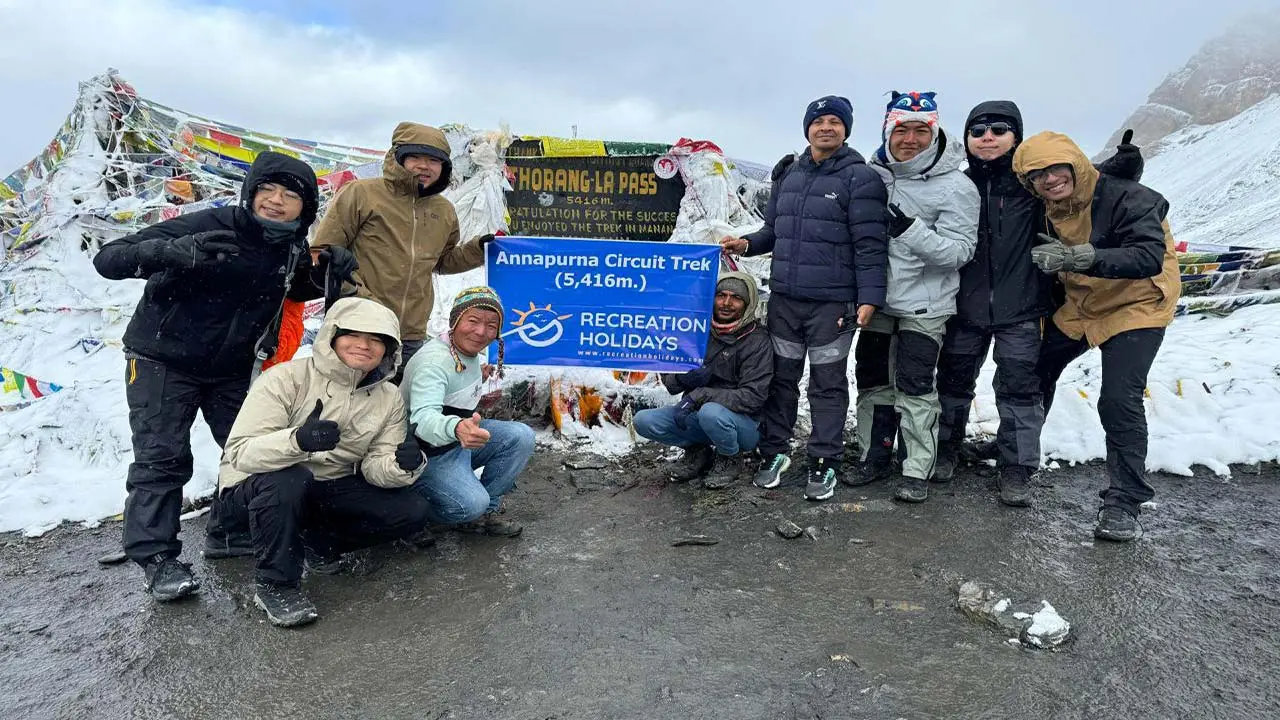
So, the average trekking period in this trek is about 5 to 6 hours per day. You won’t follow the straight line for these long hours, you will need to traverse rugged and rough mountain terrain composed of river crossings, loose rocks, steep ridges and icy scree.
Another major challenge of this high-altitude journey is the risk of Acute Mountain Sickness (AMS). After crossing 2,500 meters, the oxygen level drops significantly and it takes your body time to adjust to the thin oxygen level atmosphere. Thus, following proper precautionary methods and choosing a well-paced itinerary with a sufficient acclimatization period is an absolute necessity.
Total Trek Distance
The total Annapurna Circuit Trek 12 Days itinerary length is around 160 to 230 km (100 to 142 miles). The overall distance of the circuit journey will depend on where you start and end the trek adn whether you use transportation along the way.
With the development of the roads on both ends of the circuit (in the lower and upper Mustang region and Manang region), trekkers can now easily customize their routes to shorten or lengthen their adventure depending on their preference and the thrill they are looking for.
Historically, the full circuit trek started at Besisahar and ended in Nayapul or Phedi near the city of lakes, Pokhara. But, now, with the improved road accessibility, most trekkers begin their trek further up the valley, either from Chame or Dharapani. Then, the journey typically ends at Jomsom or Tatopani.
For those with extra days and energy, the Annapurna Circuit Trek in Nepal also number of rewarding side trips like Tilicho Lake, Poon Hill, and Nar and Phu Valleys, which can overall enrich your experience.
Accommodation and Food on the Trek
One of the most comforting aspects of trekking the Annapurna Circuit is the well-established teahouse culture. These locally run guesthouses are scattered throughout the trekking route, making it possible to trek without tents or cooking gear. You will stay at warm and cozy teahouses throughout the route.
In the developed villages like Chame, Manang, or Jomsom, you will find well-equipped teahouses with attached bathrooms (in some), hot showers and internet services. These mid-range teahouses also have cozy dining rooms with wood stoves where trekkers can socialize, enjoying warm butter tea.
However, beyond Manang, the amenities at the teahouses are more basic. Rooms are simpler with wooden bed, foam mattress, pillow and blanket. Bathrooms are often shared and hot water becomes more expensive. Most teahouses on the mountain route work based on ‘food for room’ model. So, accommodation cost is generally low, but you will need to purchase meals and food items in the same lodge.
Food During Trek Around Annapurna
When it comes to food, the Annapurna Circuit Trek 12 Days itinerary offers a surprisingly wide range of varieties, especially in the mid-altitudes. The National Trust for Nature Conservation (NTNC) does have some influence on pricing and menus are generally not controlled. But, the teahouse operators offer a similar type of menu mixed with local and international dishes to cater to the dietary preferences of the trekkers.
Food in this culturally diverse part of the mountain is more than just sustenance; it is an immersive cultural experience. Below is the overview of typical food options you will encounter for breakfast, lunch, dinner and beverages.
Breakfast
- Tibetean bread with jam or honey
- Pancakes
- Chapati
- Porridge
- Muesli or cornflakes
- Toast with butter or jam
- Eggs
- Tsampa porridge
- Paratha
- Buckwheat roti
- Fried potatoes of hash browns
- Boiled eggs
- Fresh fruits
- Fruit salad
Lunch and Dinner
- Dal Bhat Tarkari (steamed rice with lentil soup, vegetables and other side dishes)
- Fried rice
- Chowmein
- Momo
- Macroni with cheese or vegetables
- Pizza
- Spring rolls
- Sherpa stew (Thukpa)
- Garlic soup
- Roti with vegetable or lentil curry
- Shyakpa
- Sanwich
- Aloo tama
Beverage Options
- Milk/ black tea
- Masala tea
- Ginger/ lemon/ green tea
- Hot chocolate
- Fruit juice
- Instant coffee
- Mineral water
- Canned juice
- Bottled iced tea
- Apple cider
- Beerr
- Rakshi (homemade alcohol)
Packing List – What to Bring?
This legendary Annapurna Circuit Trek in Nepal takes you across multiple climate zones from subtropical lowland to high-altitude desert landscape and Himalayan pass. You will walk from the warm valleys to frigid alpine sections. So, a well-thought-out packing is essential to ensure that you are prepared for unpredictable weather, altitude challenges and the limited resources in the remote parts of the mountain.
Clothing Essentials
- Moisture-wicking base layers
- Thermal tops
- Fleece jacket
- Down jacket
- Waterproof/windproof shell jacket
- Trekking pants
- Thermal leggings
- Waterproof overpants
- Moisture-wicking undergarments
- Sun cat or hat
- Scarf or neck gaiter
- Warm beanie or insulated hat
Footwear
- Lightweight hiking socks
- Pairs of wool or thermal socks
- High-quality trekking boots
- Lightweight camp shoes or sandals
- Pair of gaiters
- Blister pads

Personal Hygiene and Toiletries
- Toothbrush and small toothpaste
- Biodegradable soap and shampoo
- Lip balm and sunscreen with SPF
- Quicky-dry towl
- Toilet paper
- Wet wipes and tissue paper
- Hand sanitizer
- Small bottle of moisturizer
- Nail clipper and razor
- Small mirror
- Foot powder or antifungal cream
- Female hygiene products
- Compact first aid kit
Equipment and Gear
- Backpack
- Duffel bag (for porters to carry)
- Sleeping bag
- Backpack rain over
- Trekking poles
- Headlamp with extra batteries
- Water bottle or hydration bladder
- Water purification filter or tablets
- Trek route map of offline maps
- Powerbank
- Universal travel adapter
- Lightweight travel lock (for duffel and room)
Annapurna Circuit Trek Permit Requirement
Understanding the permit system is critical when planning the Nepal Annapurna Circuit Trek. Nepal’s government strictly regulates trekking activities to protect its fragile mountain environment and support local communities. The permits make contributions to conservation efforts, provide safety monitoring and help preserve the cultural heritage along the trail.
Without proper permits, trekkers are fined, turned back and sometimes even banned from the region. Here are the essential Annapurna Circuit Trek permits that you will need for this journey:
- Annapurna Conservation Area Permit (ACAP)
These essential permits are issued at the Nepal Tourism Board offices in both Kathmandu and Pokhara. Don’t worry, while trekking with Recreation Holidays, we will handle all the permit requirements.
Training and Preparation
The Annapurna Circuit Trek tour is not an ordinary hike; it is a physically demanding high-altitude journey that spans across diverse terrain, climate and altitude profiles. Proper training and preparation are absolutely necessary to ensure a safe, enjoyable and comfortable trekking experience.
This trek typically ranges from 160 to 230 km (100 to 142 miles) and normally takes about 12 to 16 days to complete. You need to prepare for an average walking period of 5 to 6 hours during each day of the trek. Also, it is not a straightforward walk; you traverse the rugged mountain trails with a gradual incline all the way to a Himalayan pass.
So, cardiovascular endurance, leg and core strength are a must for this trek. If you are not that physically active, you should start your preparation at least 8 to 12 weeks before the start date. Hiking with a backpack also stimulates the real trekking conditions and will help your body adjust to walking carrying weights.
Include mental preparation in your preparation as well to develop resilience and adaptability. During this trek, you may have to deal with unpredictable weather, physical fatigue and remote conditions. So, mental resiliency is just as important as physical readiness.
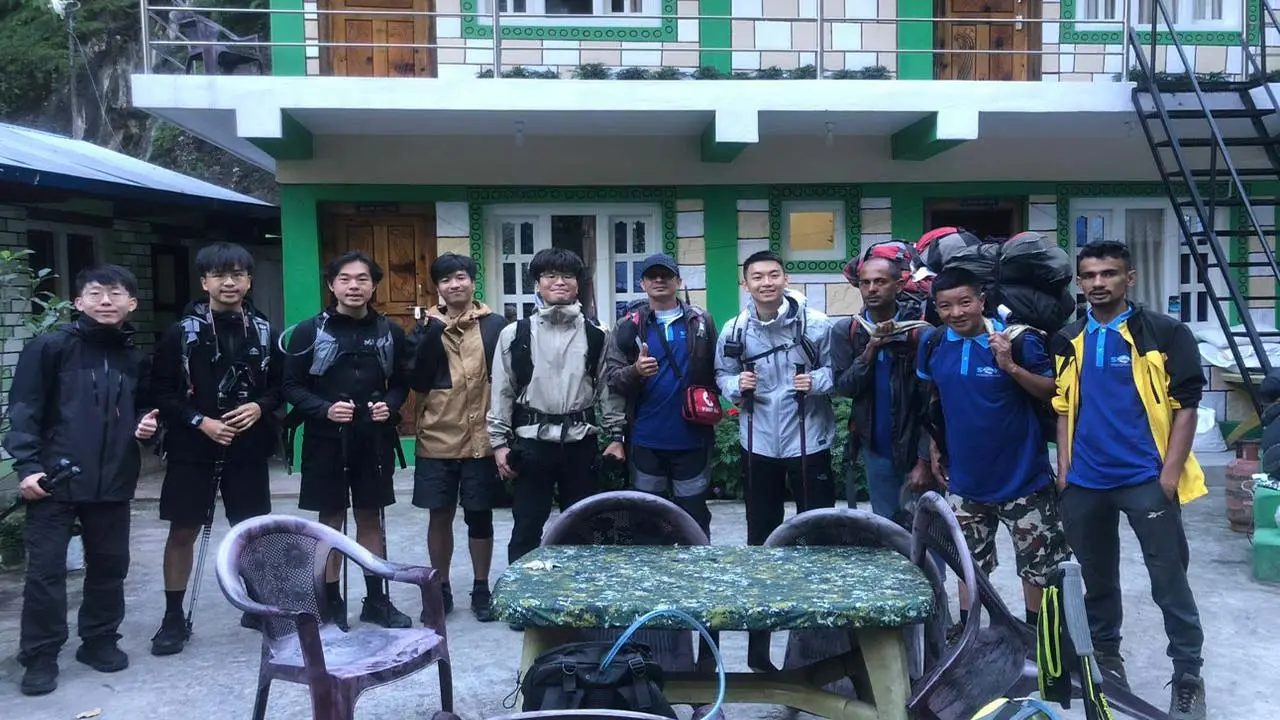
Group Joining and Private Trek
You have two primary options while booking for the Annapurna Circuit Trek Package through trekking companies: group joining and private trek. Both of these options offer unique experiences, benefits and considerations. A group trek typically involves joining a fixed departure date. Trekkers from various backgrounds and nations come together to complete the trek as a team and the journey is led by one or more certified guides and supported by porters.
As for the private trek, it is an immersive trekking experience that is arranged exclusively for you (and you chosen companions, if you are planning to trek with any). Private treks offer greater control over the itinerary plans, departure dates, accommodation and walking pace.
So, to conclude, if you are new to trekking or traveling solo and want a cost-effective and community-based experience, group joining is your ideal. On the other hand, if solitude is your fortitude and you are seeking a private and quiet journey with maximum flexibility and personalized attention, a private trek will serve you the best.
Annapurna Circuit Trek Cost
The Annapurna Circuit Trek cost for a standard package is approximately US$ 800 to US$ 1,600. This cost margin is generally for the Annapurna Circuit Trek package with duration of 12 to 16 days. Don’t take it as just a price tag; this pricing reflects an entire logistical framework built to support you in one of the most demanding high-altitude adventures on earth.
So, when you are booking through a reputable agency like Recreation Holidays, what you are really paying for is a carefully orchestrated system that removes stress, maximizes your safety, comfort and immersion. This Annapurna Circuit Trek cost estimation is only for the group joining package. If you are going for a private or a luxury trek, the price can go even higher.
A standard trek package in general provides coverage for transportation, accommodation, food, permits, experienced guide, complimentary luggage storage, first aid kit, service charge and tax. So, before jumping the gun with the cheaper package, make sure to check the inclusion section.
Customization Option and Flexible Schedules
This journey in the north-central Himalayas is not a one-size-fits-all trek. The Annapurna Circuit Guided Trek is a vast and diverse route with endless possibilities to tailor the experience that you prefer. You can freely personalize the timelines, interest, fitness level and travel goals to design an adventure of your dream.
Recreation Holidays offers complete flexibility, adaptability and personalization for you to enjoy a best value experience. Whether you are a fast-paced hiker chasing thrills or a slow traveler eeking spiritual stillness in the Himalayas, our complete customization option is the key to make sure this journey is truly yours.
In our customization option will have control over route modification, custom pacing, accommodation preference, food and diet flexibility, seasonal adjustment, flexible scheduling, etc.
Route Map & Altitude Profile
Understanding the key geography of the Annapurna Circuit Trek Map is the key to appreciating its scale, beauty and challenges. The route map below outlines this classical trail as it passes across diverse terrain from lush river valley to high-altitude deserts and Himalayan passes. Alongside the map of Annapurna Circuit Trek, we have included altitude profiles which provide clear visualization of gradual elevation gain, highlighting the key checkpoints, acclimatization zones and the highest point of the route.
Safety, Altitude Sickness and Emergency Info
Following the Annapurna Circuit Trek Itinerary is not just a physical challenge; it is a test of awareness, discipline and respect for the mountain environment. Although this circuit route is well-established and popular, the terrain is remote and the altitude is extreme. So, the safety shouldn’t be left to luck; it is secured through informed decision, proper pacing and the right support system.
The primary risk on this high-altitude route is altitude sickness. Symptoms of Acute Mountain Sickness (AMS) start taking root after you cross 2,500 meters. Even seasoned trekkers can suffer from it if they rush with their ascent and don’t give their body enough time to adapt. What keeps the trekkers safe is a combination of proper acclimatization, hydration, balanced nutrition, enough rest, self-awareness and guided oversight.
Thus, trekking through a reputable agency where experienced guides look after your health and well-being is the safest bet to take this mountain passage. Even during emergency situations, the agencies make sure their first-aid trained guides handle the situation properly. And the teams backing up the adventure will coordinate with the rescue logistics if it is necessary.
Cultural Insights
The trek around Annapurna Circuit is not only a journey across the dramatic Himalayan landscape; this adventure also dives deep into the rich cultural fabric of Nepal. Your trekking trail weaves across the ethnic mountain communities, ancient traditions and spiritual landmarks that offer a unique window into the Himalayan life. The Annapurna region is home to diverse ethnic groups such as Gurung, Thakali, Magar, Manangi and Tibetan refugees near Kagbeni and Muktinath.
Each of the ethnic groups has distinct language, customs and spiritual practices. You will find Buddhism and Hinduism coexisting harmoniously through the circuit route. Prayer flags, chortens and mani walls are a common sight during each day’s adventure. You will also get the chance to explore some of the major spiritual sites in the region like Braga Monastery, Karma Samten Ling Monastery and Muktinath Temple.
At the higher part of the trail, most of the traditional homes are made of local stone with slate roofs and they also have flat courtyards. As you will stay in the family-run lodges, this will allow you to directly interact with locals. So, you will get a first-hand experience in their culture, traditions, customs and understand how they have adapted to the Himalayan life.

Cultural Dos and Don’ts
Dos
- Greet people respectfully using “Namaste” in Tibetan-influenced villages you might hear “Tashi Delek”
- Remove shoes and hats before entering monastery, temple or someone’s home
- Walk around stupas and mani walls in clockwise order, turn the prayer wheels clockwise as well
- Dress modestly, covering your shoulders, chest and knees, especially in remote villages and religious places
- If offered tea or food, accept with right hand or both hands; never use left hand only
- Be respectful to elders, stand up or slightly bow while greeting elders in villages
- Step aide for porters and yaks carrying heavy loads (not on the cliff side)
- Keep the noise levels low in villages and monasteries, locals value peace
- Bargaining is allowed, but don’t haggle aggressively
- Respect nature as part of culture
Don’ts
- Don’t touch head or point with feet at people or shrines
- Do not enter kitchen area or touch cooking utensil unless invited
- Avoid public display of affection
- Don’t take photos of people and monks without permission, some might dislike it
- Do not disturb monks or religious ceremonies, sit quietly if you wish to observe
- Don’t waste food, especially in high-altitude villages where supplies are carried by yaks and porters
- You shouldn’t give money or candy to children, if you wish to contribute, you can donate to schools or community projects
Helicopter Return Options
For the trekkers who want to shorten their journey or end the iconic mountain adventure in style, the helicopter return option offers a fast, scenic and popular alternative for trekking or ground transport. It is an ideal return option for those trekkers with time constraints, physical fatigue,a latitude-related concern, or for those who simply want a luxury experience and end the journey on a high note.
There are several popular helicopter pick-up points. You can take the helicopter flight back to Kathmandu or Pokhara from popular destinations like Muktinath, Jomsom, or Manang. Taking a helicopter flight back helps you save 2 to 4 days of the Annapurna Circuit Trek itinerary, offers you comfort and rewards with scenic aerial views of Himalayan peaks and Kali Gandaki Gorge.
Travel Insurance and Emergency Rescue
The Annapurna Circuit Trek in Nepal is one of the world’s most iconic experiences. But, this journey takes you across remote high-altitude Himalayan terrain where the risks are real and rapid medical assistance is limited. So, proper travel insurance and a clear understanding of the emergency evacuation procedures are essentials. The altitude, remoteness and unpredictable weather conditions make the Annapurna region a challenging environment.
Many villages in remote parts of the mountain have no road access. Likewise, the health posts are also in limited number. So, in case of any kind of emergency, if you have to pay for a helicopter rescue operation without insurance, it can cost you thousands of dollars. Getting a good insurance plan for high-altitude trekking has several beneficial aspects, such as:
- Coverage for expensive helicopter evacuation
- Medical treatment coverage
- Protection against altitude sickness emergencies
- Trip cancellation or interruption protection
- Coverage for lost, stolen, or damaged gear
- Support service
- And, peace of mind for you to focus on enjoying the trek
Internet, Connectivity, Charging on the Trail
The Nepal Annapurna Circuit Trek may take you deep into the Himalayas, but it doesn’t mean you will be completely cut off from the world. Internet and mobile connectivity are available along much part of the trail. However, they get slower, patchier and more expensive as you climb higher into remote villages. Charging your devices is also possible along the teahouses, though it comes at a cost and is often limited due to reliance on solar panels or small hydropower systems.
Most teahouses in popular stops provide WiFi services. They may not be reliable for large uploads or video calls, but they are decent enough for messaging and emails. You also have the option to use mobile networks like Ncell and NTC that offer different data packages. However, their service range may often be limited above 3,500 meters.
As for charging, teahouses do allow you to charge your devices, but it will cost on a per-hour basis. At the higher altitudes, the villages are dependent on solar panels. So, charging may be available for a few hours a day. It's best if you bring a powerbank, which can be a lifesaver during days without charging facilities. A portable solar charger can also help you juice up your devices while spending time outdoors.
Porter and Guide
This high altitude adventure in the central part of the Himalayas is more than just a long hike. It is a demanding journey that pushes you physically, mentally and emotionally. Over the 12 to 16 days of trekking, you will traverse across steep ascents, rock trails, suspension bridges and high-altitude passes, reaching as high as 5,416 meters (17,770 feet) at Thorong La Pass.
You will also pass through the remote Gurung, Thakali and Tibetan culture-influenced villages, where language barriers and cultural nuances can be challenging for solo explorers. If you are a first-time trekker, unfamiliar with high-altitude trekking, or want to enjoy a stress-free adventure, then hiring a government-licensed and helpful porter can enhance your overall experience. Here is what hiring guide and porter add to your Annapurna Circuit Trek in Nepal:
- Safety and expert guidance in unpredictable mountain conditions
- Peace of mind when dealing with emergencies or altitude sickness
- Deeper cultural immersion and more meaningful interactions with locals
- Physical relief by letting the porter carry your heavy gear
- Save your energy for tougher sections and actually soak in the journey without worrying about weights
- Accurate itinerary and acclimatization planning
- Up-to-date trail information
- Support in emergencies
- Encouragement and motivation to push through difficult sections
Travel Visa
All foreign nationals (except Indian citizens) need a Nepal Tourist Visa to enter the country. Nepal has one of the most traveler-friendly visa systems in South Asia. Obtaining a visa is an easy and seamless process for most international visitors. There are several options for obtaining a Nepali tourist visa include visa on arrival, e-visa and embassy-based visa applications.
The most common and convenient method is the visa on arrival, which can be obtained at the Tribhuvan International Airport (TIA). Or, you can obtain it at major land borders like Sunauli, Kodari, or Rasuwa. At the airport or designated land entry points, you can find an electronic kiosk at the immigration area where you can fill out a visa form and proceed to the counter with your document and fee (bring a copy of your document if you have filled the form online).
There are three types of visa on arrival that you can apply for:
- 15 Days Visa— US$ 30
- 30 Days Visa— US$ US$ 50
- 90 Days Visa— US$ 125
For extension, you can get a minimum 15-day period which will cost US$ 45. You will need to bring a valid passport with at least 6 months' validity from the period of your arrival, passport-sized photographs, cash for visa fees and a completed arrival card (available at the airport).
Responsible and Sustainable Trekking Practices
The trek around Annapurna isn’t just a breathtaking experience across dramatic Himalayan landscapes; it's also a journey through deeply rooted local cultures, fragile mountain ecosystem and communities. With thousands of trekkers passing through here annually, the impact we leave behind really matters. So, responsible and suitable trekking practice is not optional; it is essential.

- Minimize your waste avoid buying plastic water, bring reusable water bottles instead and use water purification tablets
- Pack out everything you bring in, especially the non-biodegradable items
- Use the local resources mindfully, as a trekker it is important not to strain these fragile supply chains
- Respect the local culture, traditions and religions, being a responsible trekker also means being a culturally sensitive visitor
- Stick with the leave no trace principle, take only memories and leave only footprints
- Choose eco-certified lodges and homestays during the trek
- Avoid off-trail walking to protect the fragile ecosystem
- Don’t pollute the water system, use designated toilets and avoid shampooing or washing directly in streams or lakes
- It's best if you eat local, seasonal and vegetarian meals, especially at higher altitudes, which significantly reduces use of imported, packaged, or frozen goods
- Hire local guides and porters to empower the community
- Respect the porters and locals, give them right of way
- Educate yourself about conservation mission, flora and fauna, local ethnic groups and cultural sensitivities before you go
Annapurna Circuit Trek 12 Days FAQs
Yes, the Annapurna Circuit Trek in Nepal is still one of the most iconic treks. Despite some road development, the core trail offers stunning Himalayan views, diverse culture and epic Thorong La Pass. This variety of scenery, culture and altitudes makes it an incredibly rewarding trek.
Annapurna Circuit is generally safe with proper preparation, but altitude sickness, weather shifts and landslides (in monsoon) are some risks that you need to look out for. Acclimatize well, stay updated on weather, avoid rushing your ascent and trek with an experienced guide for an enhanced experience.
This thrilling high-altitude journey has moderate to challenging difficulty level. The trekking trails are not technical, but the altitude gain, long days of walking and remoteness of the region can be demanding factors.
The best months to hike Annapurna Circuit are March to May and September to November. These periods offer clear skies and stable weather, you should avoid off-season like monsoon and winter unless you are an experienced trekker.
Typically, it takes around 12 to 16 days to hike Annapurna Circuit Trek map. But, depending on the start/end destination, walking pace, transportation use and side extensions, the journey can be longer or shorter.
Yes, a beginner with a decent level of fitness can complete this trek without any issues. The key for a successful trek is not rushing, acclimatizing properly and trekking with expert guides.
The hardest part of trekking Annapurna Circuit is crossing the Thorong La Pass (5,416m/ 17,770ft). This is the highest and most challenging part of the trek due to its altitude, steep ascent and early morning cold wind.
You don’t need to be in an athlete’s shape to do this trek; just a basic level of fitness will suffice. However, you should be able to walk multiple hours (6 to 7 hours on average) on the high altitude, rugged Himalayan route carrying your backpack.
The Annapurna Circuit is longer with more varied terrain; the Everest Base Camp Trek is higher in altitude. But, trekking Annapurna also included a tougher high pass, so the difficulty level is pretty much similar.
Although the teahouses/lodges do offer warm blankets, for nights ta higher altitudes,a sleeping bag is strongly recommended. Night and early morning temperatures can drop significantly near and above alpine zones, so a sleeping bag is a basic necessity.
For those looking for short itinerary plans, Short Annapurna Circuit Trek 10 Days is an ideal option. This is the shortest and safest itinerary plan for this route, which doesn’t compromise in integrity and the Himalayan experience.
Everest Base Camp Trek offers iconic mountain views and Sherpa culture, while the Annapurna Circuit has more landscape diversity, cultural variation and fewer crowds. Trekking Annapurna suits those looking for variety while EBC appeals the Everest seekers.
Yes, Annapurna Circuit can be completed within 10 days with careful planning and skipping some part of the trail via jeep. But, you need to choose a well-crafted plan with proper acclimatization routine to safely complete the journey.
Solo trekking in Nepal has been banned since April 2023 in Nepal considering the safety aspects and risks in high-altitude remote route navigation. Hiring a guide for the trek will ensure safety, help you with an acclimatization schedule, bridge the cultural and language barrier and enhance the overall experience.
This circuit route is safe for the trekkers who are well-prepared, follow proper acclimatizaion schedule and avoid the off-season challenges. Doing the trek with a reputed agency increases safety, comfort and immersion factors.
Travelers’ Review
My friend and I planned a trekking trip to Nepal in Annapurna circuit and chose Recreation Holidays for the adventure. I contacted Mr. Hari Kadariya for guidance on...
My friend and I planned to go to Nepal for trekking, and I found Recreation Holidays for the trek. I contacted Mr. Hari Kadaria for guidance on...
This is the first time I came to Nepal for trekking, and I chose the Annapurna Circuit Trek for my adventure and selected Recreation Holidays for it. I’ve done many...

